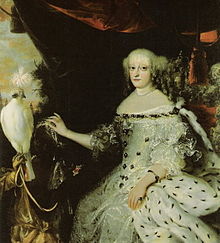Sophie Amalie of Brunswick-Lüneburg
| Sophie Amalie of Brunswick-Lüneburg | |
|---|---|

Portrait by Abraham Wuchters, c. 1670
|
|
| Queen consort of Denmark and Norway | |
| Tenure | 28 February 1648 – 9 February 1670 |
| Born | 24 March 1628 Herzberg Castle, Lower Saxony |
| Died | 20 February 1685 (aged 56) Amalienborg Palace, Copenhagen, Denmark |
| Burial | Roskilde Cathedral |
| Spouse | Frederick III of Denmark |
| Issue |
Christian V of Denmark Anna Sophia, Electress of Saxony Frederika Amalia, Duchess of Holstein-Gottorp Wilhelmina Ernestina, Electress Palatine Prince George, Duke of Cumberland Ulrika Eleonora, Queen of Sweden |
| House | Hanover |
| Father | George, Duke of Brunswick-Lüneburg |
| Mother | Anne Eleonore of Hesse-Darmstadt |
| Religion | Lutheran |
Sophie Amalie of Brunswick-Lüneburg (24 March 1628 – 20 February 1685) was queen of Denmark and Norway as the consort of the King Frederick III of Denmark.
Sophie Amalie was born at the Herzberg Castle, in Herzberg am Harz. Her parents were George, Duke of Brunswick-Lüneburg and his wife Anne Eleonore of Hesse-Darmstadt. Nothing is known of her childhood.
Sophie Amalie married Prince Frederick in Castle Glücksburg on 1 October 1643 and lived in Bremen. The marriage was arranged in 1640 as it was considered suitable for the current situation of the groom: he was, at that point, archbishop of Bremen and not heir to the throne. It is believed to be a policial match, though the exact purpose of it is unknown. In 1646–47, they lived in humble circumstances in Flensborg, after having been forced to flee Bremen during the war between Denmark and Sweden. In 1647, Frederick was elected heir to the Danish throne, and the following year, she followed him to Denmark.
She became Queen of Denmark in 1648. They had 8 children, including King Christian V of Denmark and Ulrike Eleonora of Denmark who married King Charles XI of Sweden.
Sophie Amalie loved hunting and, in spite of the dire financial situation of the Kingdom, she was the centre of a sumptuous court life, with exclusive luxury items and grand parties, which shed glory on the royal power. She enjoyed fashion, parties and theatre, arranged masquerades and made the French taste fashionable in Denmark. As her husband was introverted, she became the centre of the social life at court. Among her favorite courtiers and intimate friends were Abel Cathrine.
She remodelled the court after a French and German pattern. In 1649, a large order of items arrived for the new court life she arranged, followed also by new staff and new positions. She hired a German chapel master, Kaspar Förster, a French violin orchestra, a French ballet master, D. de Pilloy, and a French court singer and dancer, Anne Chabanceau de La Barre. The Spanish Ambassador, Bernardino de Rebolledo, dedicated her his poems. Ballet, masquerades and theatre performances were performed, and she and her children participated in amateur theatre with the nobility: in 1655, she performed five different parts in a ballet at the same occasion. The waste of money in a poor society was not well received by the public.
...
Wikipedia
